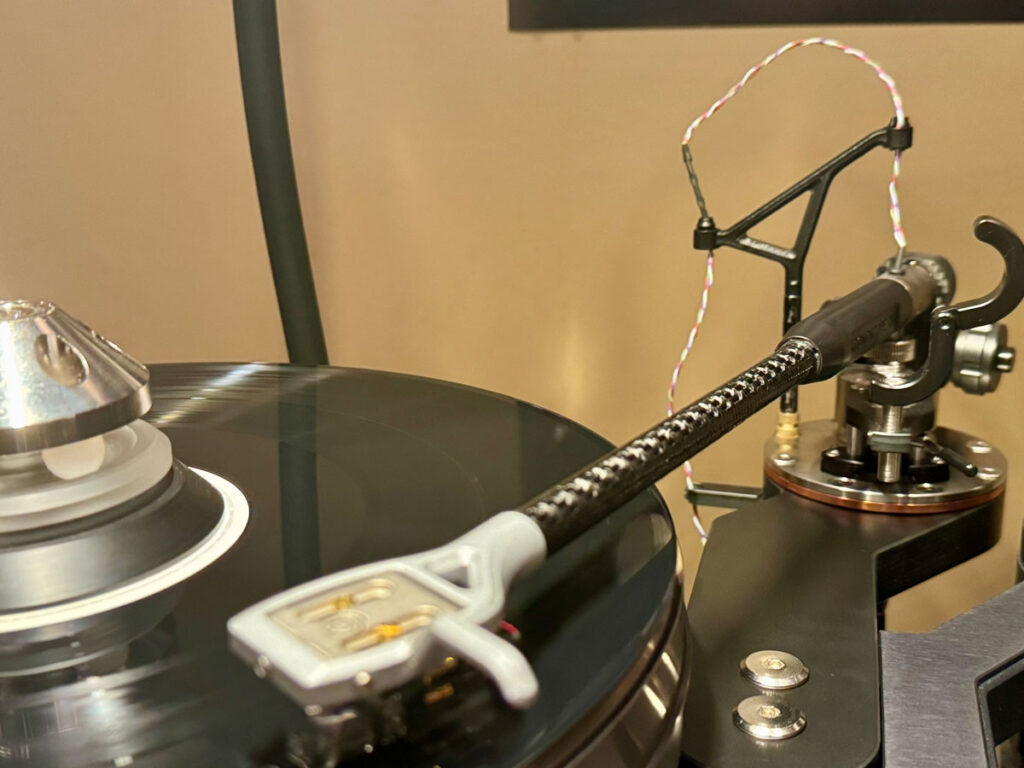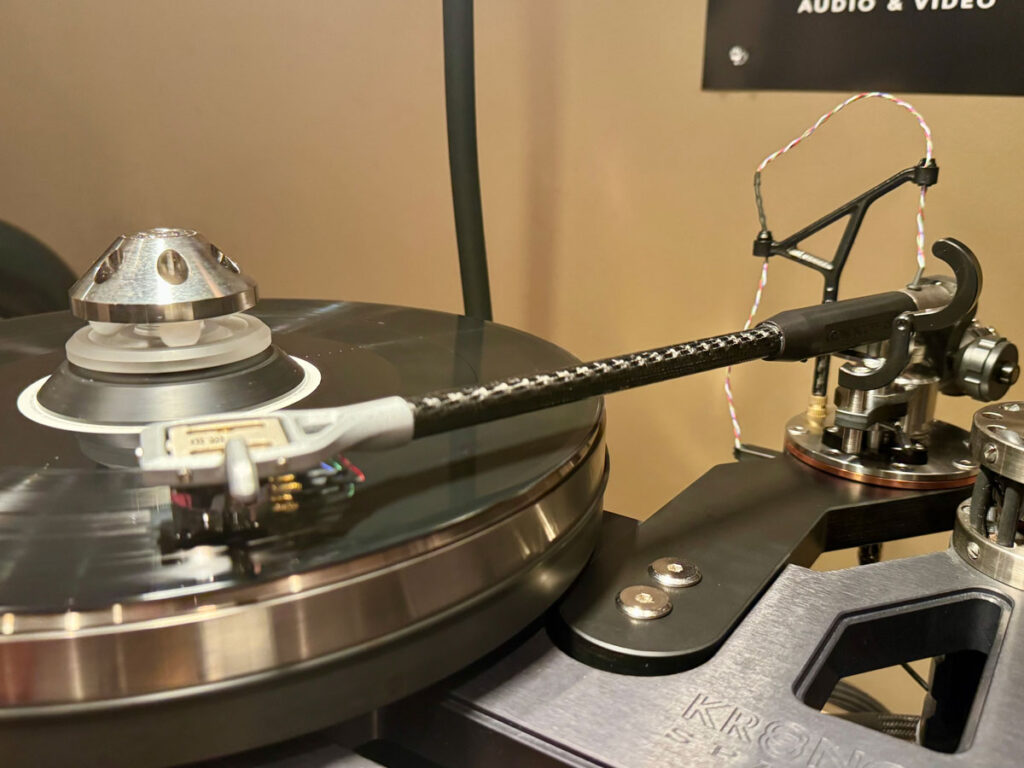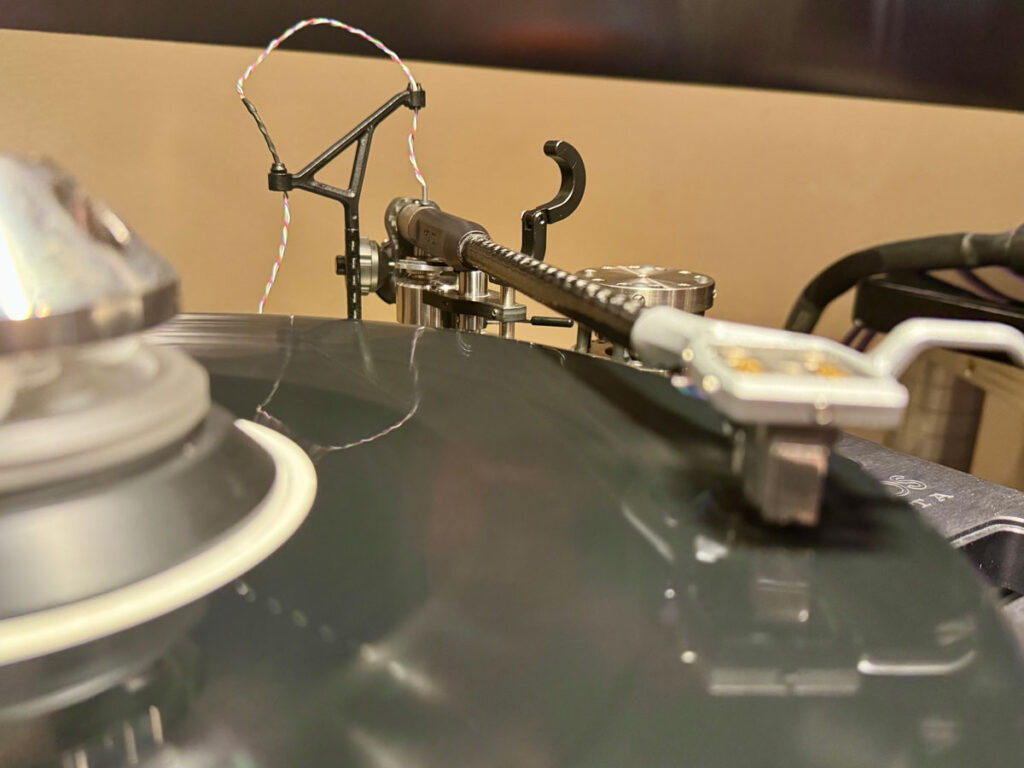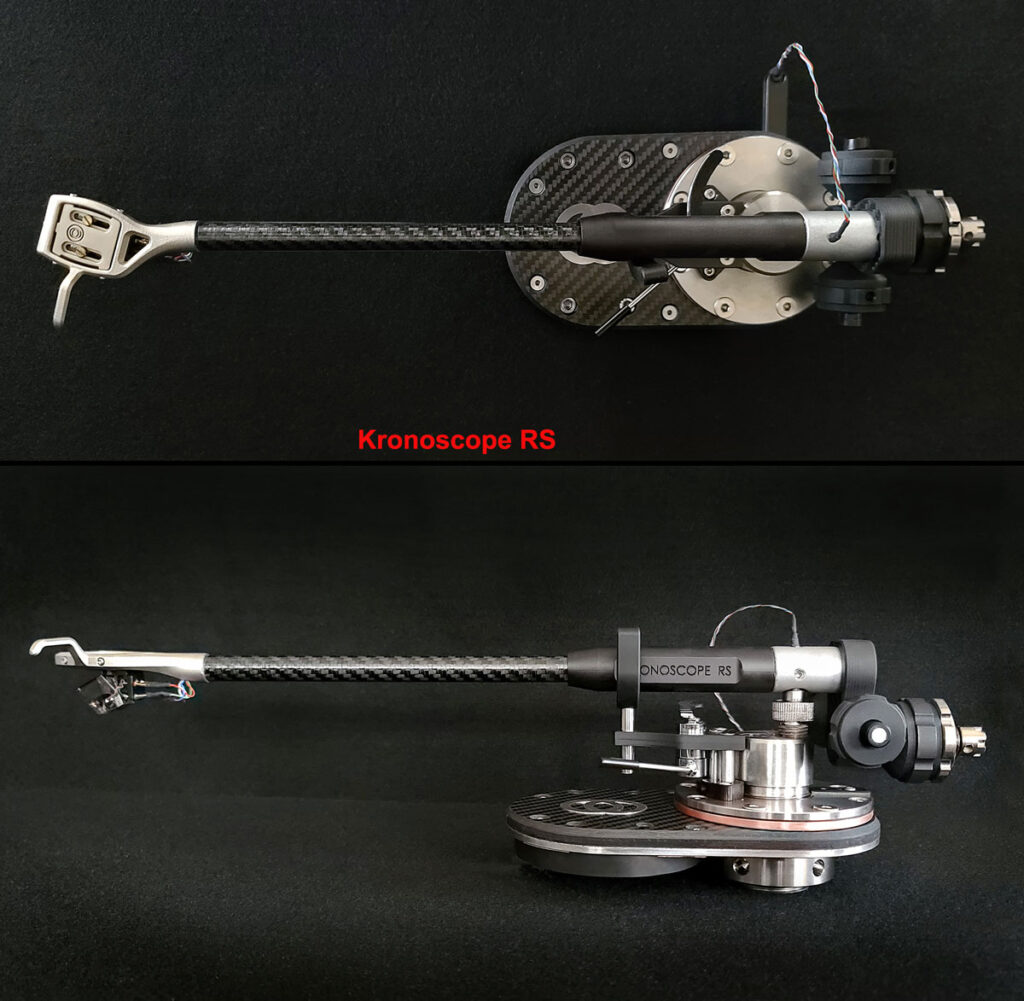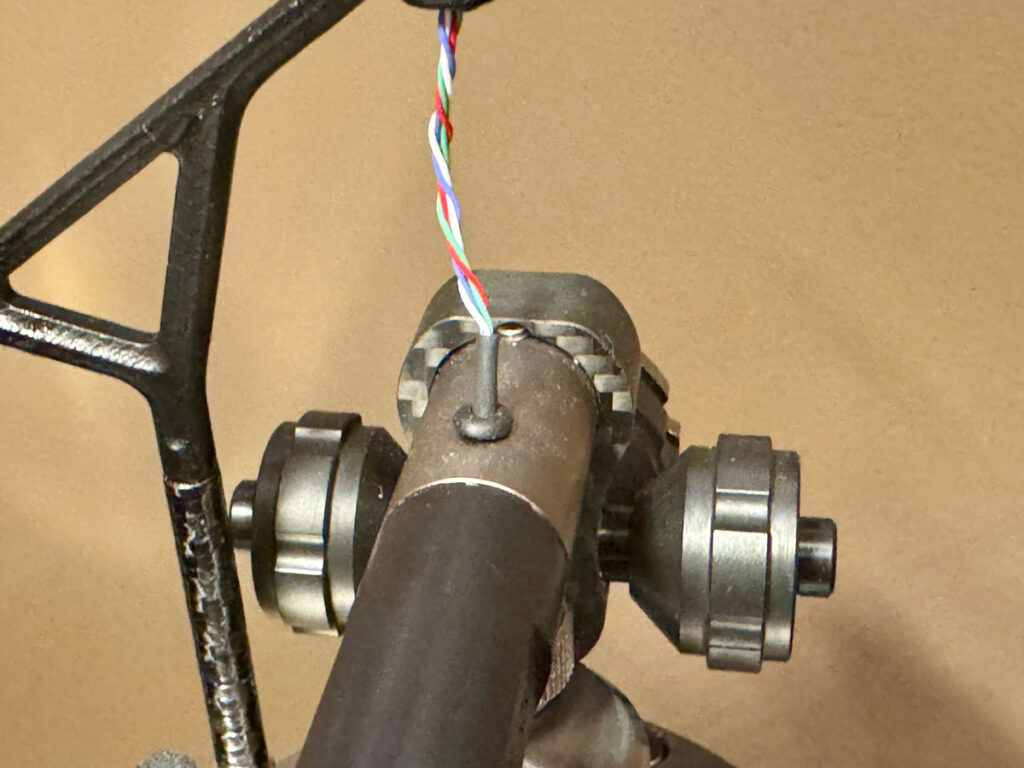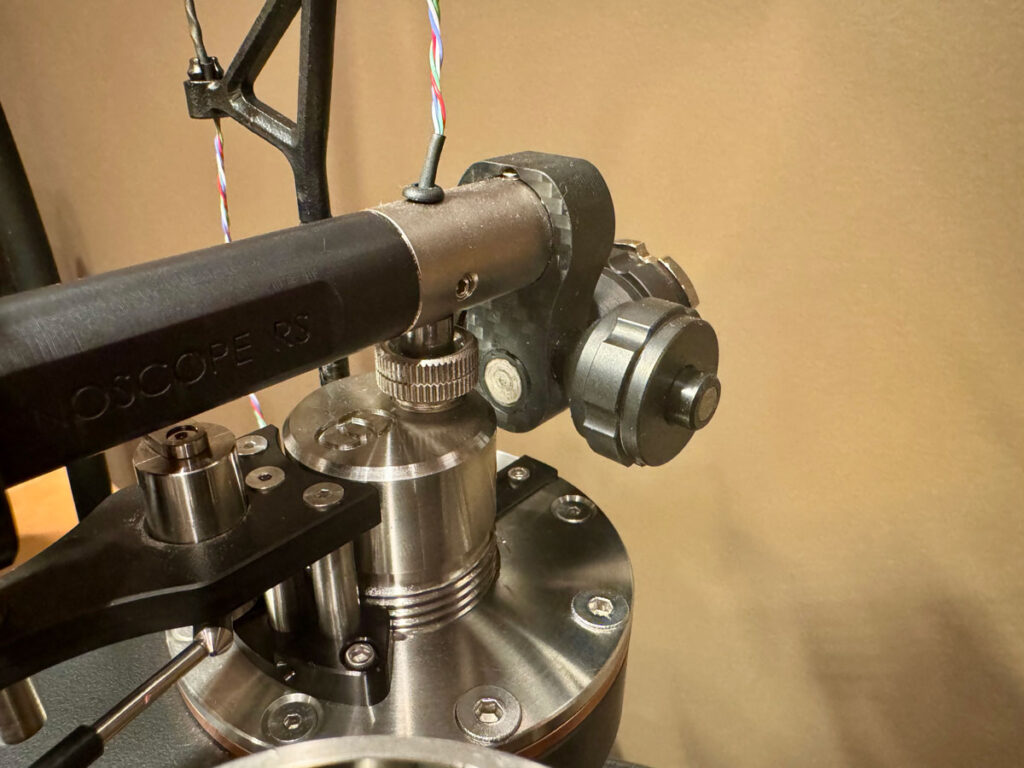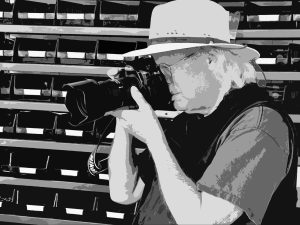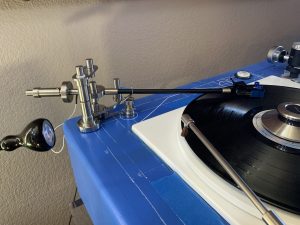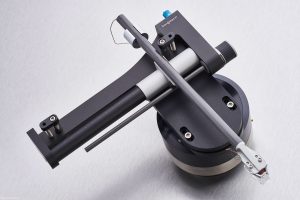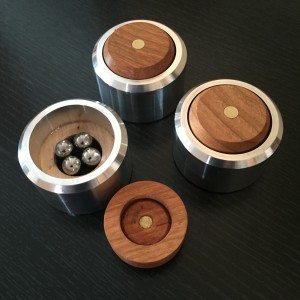New Kids on the Block
Back in late fall 2021, as most of the nation impatiently wiped layer upon accumulated layer of sleep from COVID-19 weary eyes, GTT Audio & Video's head honcho Bill Parish bravely invited a small group of reviewers to his sprawling suburban New Jersey listening rooms, amongst the finest such spaces I have ever seen and heard, to evaluate maverick turntable designer Louis Desjardin's then latest assault on the state of the analog audio arts, the magnificent Discovery turntable.
In all my years spent, first listening to and later, reviewing high-end gear, I had never heard anything quite like the Discovery and its matching Kronoscope tonearm. Following this ear, and eye-opening initial encounter, I provisionally concluded that "the Discovery/Kronoscope/SCPS (Super Capacitor Power Supply) system heralds a new paradigm in vinyl replay, one that eviscerates, from the ground up, what most of us imagined were the demonstrable outer limits of the medium. By the same token, the D/K/S combo made abundantly clear that digital replay still has a long road to travel before it can match the realism, life, and tonal expressiveness of vinyl replay at its absolute best (HERE)."
Unwilling to rest on his not so inconsiderable laurels, Desjardins, the enfant terrible of the turntable design world, recognized soon after the introduction of Discovery to the unprepared audio masses that he could push sonic boundaries even further. All those months, weeks, days, and hours spent designing the turntable convinced him that he could, and should, download as much of the turntable's resonance-suppression thinking (hence the product "RS" designation) as practical to a new line of reference tonearms. Enter: the Discovery RS and Kronoscope RS.
Both deserve the sonic appellation "reference" (more on this point later in the review), the Discovery sounding that little bit more resolute, dynamic, and composed than the Kronoscope. Pricing reflects the reference-level aspirations of both arms: $24,000 for the Discovery and a smaller but still considerable $14,000 for the Kronoscope RS. Readers should note that the Kronoscope RS is the direct replacement for the original Kronoscope tonearm designed to mate with the Discovery turntable. The earlier Kronoscope tonearm, along with the older Black Beauty and Helena models, is no longer in production. The Discovery RS tonearm occupies an even loftier perch, functioning as a true statement piece for the company.
When I visited Montreal a while back to attend an academic conference, a lunch outing with Louis and a trip to the Kronos factory led to a simple question: would I like to hear the Kronoscope RS tonearm in my home system and later share my impressions with readers? I answered in the affirmative, but with the understanding that I didn't feel entirely comfortable installing such an expensive piece of kit onto my turntable. My then current arm, Jelco's lovely TK-950A, sounded just swell and at about $2000 retail, remained affordable and was easy to use and set up. By the way, am I the only music lover to lament the passing of this storied audio brand? The Kronoscope RS was a whole different animal. Fortunately, a phone call to my dear friend Greg Weaver solved this problem, the good Papa Weaver agreeing to help me install the arm on my Kronos Sparta 0.5 table. Not long after the conference, the KRS arrived in Orlando, followed shortly by Greg who expertly installed the arm and realigned my entire system to striking musical effect.
At $24K and $14K respectively, the new Discovery RS and Kronoscope RS tonearms aren't cheap. To that end, please allow me to reflect on tonearm pricing and recent vinyl replay history for a bit. Twenty years ago, the Discovery RS and Kronoscope RS price points would have sent shock waves throughout the high-end universe. Back then, tonearms priced above the seven or eight-thousand-dollar level would have raised both eyebrows and audiophile anxiety levels. For years, arms like the Linn Ekos SE, the SME Series V, various models from Tri-Planar, and a handful of others dominated what I would describe as the old-world tonearm upper-crust segment of the market. With upper-tier tariffs in the $4K-5K range, these arms offered outstanding performance at high, but not extreme price points. Rarer exotic gear like the superb Ikeda line of arms appealed to vinyl addicts willing to spend a bit more, say $6K-9K, but arms above that point proved quite rare.
A bit later, a small number of designers who offered dedicated arms built to work specifically with their own turntables (think Continuum Audio's advanced Cobra tonearm which cost about $11-12,000 when last available) pushed the price envelope higher still, but such arms typically did not see use in systems other than those for which they were designed. By the mid-2000s, low-volume, high-precision arms from outfits like DaVinci Audio Labs would tilt the tonearm price-point ceiling still higher. For example, DaVinci's lovely Virtu arm cost $14,795 in 2013, about what the Kronoscope RS costs in 2024 dollars. The point of no return came in 2014 when the SAT (Swedish Audio Technologies) tonearm hit the global market at a then whopping $28,000. From that point forward, anything seemed possible, at least price wise. Indeed, the current top-of-the-range SAT tonearm, the SAT CF1-09Ti, today costs a whopping $105,600. Let me suggest that in context, the Kronos arms, while certainly expensive, hardly seem excessive in today's dollar/euro/yen/pound pricing firmament.
More importantly, given the prices of Kronos's currently available turntables ($125,000 for the nonpareil Discovery, approximately $75K for the new Perpetual, essentially a scaled-back Discovery, and $24K for Sparta), $14,000 for the Kronoscope RS and $24,000 for the Discovery RS tonearms seems neither excessive nor disproportionality high given the cost of the associated vinyl spinners. Please note that the Kronos Pro, a limited-edition model, recently reached its run of 250 tables and has thus been retired.
Design Basics
Before I delve further into what makes the Kronoscope RS so special (paired here with my personal reference, the Kronos Sparta 0.5 turntable), I should note that I won't spend too much time here discussing the technical and engineering choices that went into the arm's design (something our own Greg Weaver does superbly in his excellent review of the Discovery RS tonearm HERE). Aware of the extensive technical overview provided in Greg's review, I promised Louis that I would primarily discuss how the lower-priced arm sounds and only highlight key technical points when necessary.
Still, a little design philosophy background discussion is useful in understanding why the Kronoscope RS sounds the way it does. As I indicated above, the "baby" Kronos arm downloads a healthy dose of the resonance-suppression strategies first utilized in the Discovery turntable. A core set of engineering principles drove the design process. First and foremost, Louis and the Kronos team understood that the turntable/tonearm/cartridge system's ability to isolate the musical signal embedded in the LP from all other non-groove vibration artifacts (what my good pal Greg Weaver calls "parasitic vibrations") largely determines how accurately and convincingly a given system can reproduce all the finely filigreed information buried in those same grooves.
To this end, starting with the Discovery table, and thence to the arms, the Kronos team utilize materials boasting different resonant Q factors (aluminum, copper, carbon fiber, and resonance-tuned and compressed phenolic) to create modular structures that effectively isolate the various component parts, one from the other, both mechanically and compositionally. Simply stated, if the aluminum portion of Discovery's massive platter resonates at all (its weight mitigating against that result), those artifacts would "sound" at a different frequency point and quality or "Q" from the resonant behavior of the platter's copper layer. This constrained layer damping (CLD) strategy minimizes the likelihood that the resonant behavior of any one component or component part will interact (and amplify) deleteriously with the resonant behavior of any of the other constituent system component parts.
So, instead of designing a massive all-aluminum platter, the Kronos team crafts their spinners from a precisely voiced formulation of aluminum, copper, and resonance-tuned and compressed phenolic, better to banish interactive parasitic vibrations to the ether.
The Discovery RS and Kronoscope RS arms employ the same CLD design strategies that Desjardin deployed in his top-of-the-line turntable. As Dr. Weaver summarized so elegantly in his write-up of the Discovery RS arm (HERE) "by implementing the technologies… applied building Discovery, Kronos… came up with a system of technologies and approaches that would effectively allow for the interruption and minimization of wave transmission throughout the entire length of the tonearm itself." Desjardins has applied for a patent, so novel is his approach to tonearm design.
So, what precisely does this near-fanatical obsession with resonance suppressed, constrained layer damped, modular tonearm construction deliver musically? In my experience, those listeners fortunate enough to have heard a properly set up Kronos turntable/arm combo uniformly praise the associated system's sound, all the while struggling a bit to qualify impressionistically what about the sound so excites them. It's not just casual listeners that struggle here. Seasoned audiophiles and more than one critic that I know frequently fall silent when asked to convey in impressionistic terms precisely why they find the Kronos sound so disarmingly natural and musically compelling, meaning so damn lifelike.
Just re-read the joint assessment that Positive Feedback's David Robinson, Greg Weaver (also of PF fame), and I offered (HERE) after spending a couple of amazing days reveling in the sound of the then brand-new Kronos Discovery turntable/Kronoscope arm (the original model) combination. David used the phrase "sui generis" repeatedly during our visit to GTT Audio & Video, and again in his portion of the 3-author collaborative review project to convey the singularly revelatory experience he had when he first heard the Discovery system. For my part, I marveled at the system's "at the mic" directness and focus, while Dr. Weaver enthused that he had never, not in his almost three decades of reviewing high-end gear, heard anything quite as towering as the Kronos system.
Read another way, one would not be wrong to conclude that each of us struggled to various degrees to describe what we heard in impressionistic terms that made sense. Hell, the three of us essentially admitted as much in our separate assessments.
Sound from Silence
Having experienced the "baby" Kronos tonearm in my home system for a considerable amount of time, I now have a much better sense of how the device sounds and will do my best to share those impressions with you here. Four telltale qualities characterize what I will refer to as the Kronos house sound. Not surprisingly, these qualities align one-to-one (almost) with those sonic indicators that make listening to the Discovery turntable such a musically revelatory experience. For starters, the system reproduces great vinyl (properly cleaned I should add; I use the superb Degritter Mark II to scrub my discs) as noiselessly as a good tape player, along with tape's unflinching sense of superb stability and continuousness.
Fans of Impex's fine reissue of Columbia's lovely Shostakovitch: Piano Concerto No. 2 (Impex), originally a famed six-eye, will marvel at the absence of both obvious groove noise and the subtle "whoosh-whoosh" background white noise overlay that one typically hears with even outstanding vinyl playback systems. In practice, listeners consciously filter out the white noise artifacts by concentrating on the music and ignoring the rest, to the extent possible. The Kronos arm effectively frees the ear/brain interface from the burdens of this type of conscious bio-electric filtering, allowing the listener to focus on the music alone. To appreciate the magnitude of this achievement, one needs to understand how the ear/brain interface interprets music.
With the use of advanced magnetic resonance imaging (MRI) and other modern scanning technologies, audio researchers have discovered that the brain decodes music transmitted from the ears by directing the incoming signal to multiple processing sub-stations, not to a single central processing hub. In effect, different sections of the brain decode (or process) the various aspects of a piece of music simultaneously. One substation unravels beats and rhythms, while yet others decode tonality, pitch, timbre, and loudness. Amazingly, advanced audiology measuring techniques reveal that those parts of the brain that control our emotions (the nucleus accumbent, amygdala, and the cerebellum for all the armchair neurologists out there) demonstrably ignite in response to music.
The upshot of this oversimplified summary spotlights a foundational overarching observation: like the delicate stylus/groove interface, the delicately balanced ear-brain interface (and its multiple interlocking elements) functions via an amazingly complex series of coordinated neurological tasks. Playback systems that deliver to the ear noiseless (essentially) musical signals make it easier for the ear/brain interface to discern and appreciate performance-related qualities like tone, timbre, timing, phrasing, and the like.
Upset one parameter in the chain and the other taskers must overcompensate, or more calamitously fail, leading to the collapse of the whole "suspension of disbelief" edifice. Tonearm and cartridge designers have long known that the reduction of parasitic vibrations that upset the delicate arm/stylus interface enhances neutrality by delivering more of the music encoded into the vinyl grooves and less noise. Stated another way, by reducing parasitic electro-mechanical system coloration, skilled designers make it easier for listeners to experience the music versus the noise because the ear/brain interface simply has less work to do.
I can't convey the impact of listening to a virtually noiseless vinyl playback system emphatically enough, and how easy such a system allows one to get lost in the music. Mind you, I have now heard Kronos systems at length in four separate contexts (not including shows): in my home system (featuring the Kronos Sparta 0.5 table with Kronoscope RS arm), in Greg Weaver's system (Kronos Pro turntable with Discovery RS arm), in system-designer Louis Desjardin's Montreal listening room (Kronos Discovery turntable with Discovery RS arm), and at Bill Parish's New Jersey fortress (Kronos Discovery turntable with Discovery RS arm). As one would expect, the Kronos Discovery turntable/Discovery RS arm-fronted systems resolve fine musical details with greater ease and capture dynamic swings better than the lower priced systems (although in fairness, Greg's Kronos Pro/Discovery RS arm combo comes alarmingly close to the performance peaks of the pricier rigs, if not quite capturing the seemingly preternatural realism of the all-Discovery systems).
But (and I say this without qualification), each system bears that hallmark sense of unshakeable composure and captivating noiselessness that I detailed above, along with the preternatural (there we go again) ability to enhance listener "suspension of disbelief" that leaves even seasoned audiophiles and reviews slack jawed.
Second, the Sparta 0.5/Kronoscope RS combo's reduced self-noise enhances the resolution of fine recorded detail to an exceptional degree. On Analogue Production's stellar UHQR reissue of the jazz warhorse Kind of Blue (Analogue Production/Columbia), the only noise apparent during home replay of the lovely Bill Evan's penned Blue in Green is the wow and flutter-sourced "whooshing" encoded in the tape master. This lends Evan's plaintive piano musings and Miles' muted trumpet (I seem to recall that Miles used a Harmon mute on this seminal recording) a three-dimensional solidity, palpability, and stability that makes the music pulse and breathe in my smallish listening room. This unique ability of Kronos-fronted systems to make the walls of the recorded venue flex, bend, contort, and pulsate as if live/alive, an experience hard to describe but easy to recognize when it occurs, doesn't just happen periodically. Rather, this sonic disappearing act exists as a constant performance feature of Desjardin's designs. Just re-read the three-part impressionistic piece that I penned along with Greg Weaver and PF's commander-in-chief David Robinson to get a taste of what I mean.
Or take a reference symphonic favorite, Mobile Fidelity's stellar reissue of the Solti Beethoven 9th (London/Mobile Fidelity)—the same disc I used in my Kronos Discovery turntable preview. Through my entry level Kronos system, I heard the French horn player entering distinctly sharp in tone during the adagio molto e cantabile movement, just like I heard him do so at Bill's place listening to a stellar Discovery-fronted system back in 2021. As with the earlier listening session, I quickly detected at home how the player promptly eased off the gas so to speak, immediately aware that he had entered the fray off-key. The key difference at home is that I had to work a bit harder to hear this self-diagnosing/self-correcting musicianship versus the "in your face" ah-ha moment exactitude that the big Discovery-fronted system delivered as an afterthought.
What you pay for as you move up the Kronos ladder then, at least in my experience, is 20x versus 15x or 16x resolution, marmoreal versus quartz-like dynamic expressiveness, and river-like versus stream-like musical continuousness.
The third aspect of the sound that continues to impress is the incredible bass power, extension, and tunefulness I encounter every time I power up my Sparta 0.5 turntable/Kronoscope RS tonearm combo. Now, I'd be the first to admit that I can't unequivocally proclaim the bass performance of the Kronos-fronted systems that I've heard over the years as audibly superior to the bass performance of other top analog setups. The many Acoustic Signature-fronted systems that I've encountered, not to mention the lovely Thales table/arm combos and refurbished Thorens and Garrard models all impressed me deeply with their musical continuousness, naturalness, bass reach, and sheer low-end heft. The same holds true for the TechDAS models that I had the pleasure of hearing at audio shows.
To my ear, the Kronos-fronted systems that I've encountered get the provisional nod here owing to their beneath-the-floor bass weight and impact, superior pitch precision, and outstanding rotational stability, all the above coupled to the brand's vanishingly low self-noise performance. Not to beat a dead horse into the ground, but it stands to reason that if all other sonic metrics weigh in about equally, meaning here overall system bass performance, the system that most effectively suppresses or, better yet, eradicates various sources of self-noise will make it easier to hear and appreciate all the things that the table/arm designer gets right.
Finally, the mini-Sparta/KRS fronted system sculpts three-dimensional soundscapes like nobody's business. Small-scale classical recordings like the lovely Argo release of the works of British composer and modernist darling Sir Michael Tippett (Tippett: Fantasia Concertante on a Theme of Corelli. Aro ZRG 680) or the equally atmospheric Philips recording of Pulitzer Prize winning composer George Crumb's eerie and haunting Black Angels (Crumb: Black Angels. Philips 6500 881) seemingly electrify my listening room with vibrant energy. Crumb's use of amplified strings to depict the so-called first "black" angel (a symbol recognized by early painters as depicting the fallen angel, Lucifer Morningstar) casts eerie images both between and beyond the speaker's boundaries, a truly enchanting spatial effect.
The effect is equally impressive in the front-to-back dimension. Every Kronos-fronted system that I have heard "layers" and sculpts images more convincingly than any system I have heard to date. Bill Parish's bunker system (Audionet reference electronics, Kronos Discovery table/arm/phono stage, Kubala-Sosna cabling, and Vivid Moya speakers—don't ask how much everything costs) does this better than any system I have ever heard, followed by the stellar sound that Dr. Weaver gets in his smaller but still usefully large bunker. I get what I consider equal doses of intimate involvement and staging precision, but nowhere near the height, scaling, and depth of layering performance that Bill and Greg obtain with their pricier setups and larger listening spaces.
Parting Impressions
In brief, combined with the musical attributes highlighted above, the littlest Kronos system, much like its more elaborately designed and pricier brethren, restores all the fun, excitement, and sheer sense of Discovery that got all of us hooked in the first place listening to well-recorded vinyl discs, just to a lesser degree.
In the here and now, I feel that the Kronos table/arm combos (Discovery, Perpetual, and Sparta tables and DRS and KRS arms) sit at the pinnacle of the possible in extracting the most from old school vinyl playback. Please note that this provisional ranking is just that, provisional. I have not heard the newest top offerings from the likes of Acoustic Signature, the recently released Thorens New Reference table, Oswalds Mill's radical K3 and K5 direct-drive models, or the latest from the Thales and DaVincini Audio Labs stables, the top TechDAS models, or the SAT XD1 system. I suspect that all these models and the various arm/cartridge combos available to them (not to mention the offerings of other top-tier players) will continue to push vinyl replay design extremes further and further out, nibbling at Kronos' fast-moving heels a bit more with each passing day. Nevertheless, as I have stated before, it strikes me as highly improbable that any single challenger can outright best the Kronos stable of tables, arms, new phono stage, and numerous playback accessories in overall musicality, vanishingly low self-noise, and the resolution of fine musical detail.
The Kronoscope RS tonearm joins the rest of the Kronos stable as a reference caliber product. It isn't cheap, but if you have the scratch, you should, without reservation, give this arm a listen. Hell, even if you can't afford the price of entry, you absolutely should, if given the chance, listen to a competently assembled Kronos vinyl playback system. I suspect that most of you will not have experienced playback of the humble vinyl LP in quite the same authoritative and transformative way.
The experience is literally nonpareil.
Kronoscope RS Tonearm
Retail: $14,000
Kronos Audio
4035, rue Saint-Ambroise,
Suite 414
Montréal (Québec) H4C 2E1
Canada
U.S. Distributor
GTT Audio
356 Naughright Rd.
Long Valley, NJ, 07853
USA
908.850.3092




